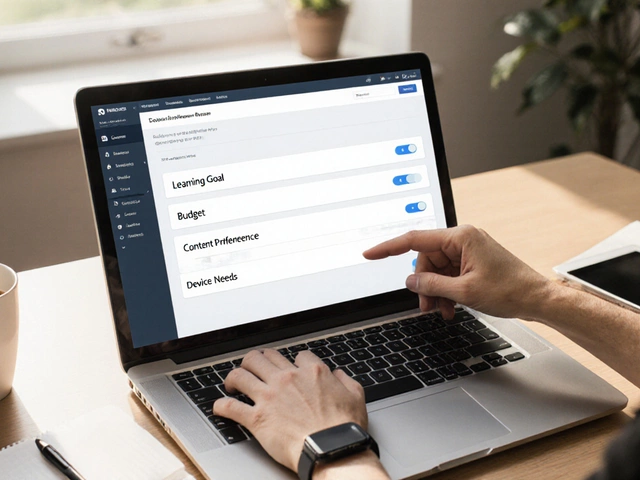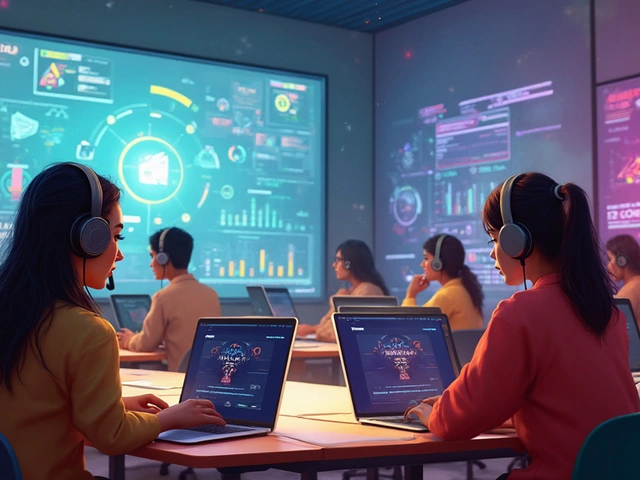
Scrolling through your phone while waiting in line? You could be halfway through a lesson without even noticing. eLearning isn’t just stuck on laptops and desktops now—pretty much every major learning platform, from Coursera to Udemy, has gone mobile. So the big question: can you seriously learn on your phone, or is it just a backup for sneaky study sessions?
Phones have come a long way. You get video lectures, flashcards, quizzes—sometimes the entire course—right in your pocket. Platforms design their apps for quick taps and short bursts of action, so you don’t need a huge screen to make it work. But there’s more to the story. Some stuff is smooth and easy, but other tasks can get clunky pretty fast.
If you’re wondering whether you should go all-in on mobile learning, there are a few things to think about. What kind of stuff do you want to learn? Do you need to type up essays, or is it more about watching videos and answering quizzes? Your experience depends a lot on what your course throws at you and how your favorite platform handles small screens.
- Is eLearning Really Possible on a Phone?
- What Actually Works Well on Mobile
- What’s Annoying or Harder on a Phone
- Apps vs. Browsers: Which Is Better?
- Tips to Make Phone Learning Easier
- The Future of eLearning on Phones
Is eLearning Really Possible on a Phone?
If you’re picturing eLearning only happening on big screens, you’re missing out. Right now, over half of eLearning traffic actually comes from mobile devices. According to Class Central, more than 60% of users on some major learning platforms hit their courses through their phones. So yeah, it’s way more common than you’d think.
Let’s break it down—most popular e-learning platforms like Coursera, Khan Academy, and Duolingo have dedicated mobile apps. These aren’t just shrunken-down versions of their websites—they’re designed to fit your screen, your thumbs, and your attention span. Even sites that don’t have apps, like Moodle, work smoothly in your phone’s browser.
Still, people want to know: Does it feel legit? Or is it just for quick reviews and basic stuff? You can pretty much access:
- Full video and audio lectures
- Interactive quizzes
- Flashcards and drills
- Assignment submissions
- Discussion forums and group chats
Check out these numbers from a 2024 EdTech report for the top mobile-friendly platforms:
| Platform | Mobile Daily Users | Percent Total Users |
|---|---|---|
| Duolingo | 15 million | 90% |
| Khan Academy | 4 million | 72% |
| Coursera | 2.5 million | 58% |
The eLearning world is all about giving you options. If you want to learn Spanish vocabulary, knock out a quick lesson between bus stops, or even submit homework—your phone can handle it. Of course, some things (like multitasking or in-depth essays) can be a bit of a stretch. But when it comes to core learning features, your smartphone is up for the job.
What Actually Works Well on Mobile
Some stuff just clicks on your phone. Watching video lessons? Super smooth, whether you’re chilling on the couch or squeezed onto a crowded bus. Most eLearning platforms like Khan Academy and LinkedIn Learning auto-adjust videos for smaller screens. You tap, it plays, no headaches.
Quizzes and flashcards are another sweet spot. Apps like Quizlet and Duolingo make it crazy easy to review terms, answer quick questions, or practice language basics. Spaced repetition tools fit nicely with push notifications, so you actually remember to study—even if it’s just five minutes while your coffee’s brewing.
Forums and chat-based features also work better than people think. In most big e-learning apps, you can ask questions, answer polls, or shoot the instructor a message, all from your phone. Media-rich content—like infographics and short audio clips—usually loads without lag, so you’re not waiting around forever.
- Checking grades or tracking your progress takes a couple of taps.
- Microlearning (super-short lessons) feels tailor-made for mobile.
- Downloading content for offline use? Super handy when you’re away from Wi-Fi.
Some courses even gamify learning with points, badges, or streaks to keep it interesting. You don’t need any geeky skills—most mobile eLearning experiences are easier than figuring out the TV remote in a hotel room.
| Feature | Works Well on Mobile? |
|---|---|
| Video Playback | Yes—optimized for small screens |
| Quizzes/Flashcards | Yes—fast and interactive |
| Progress Tracking | Yes—easy with simple dashboards |
| Forums/Chats | Decent—quick replies, notifications |
| Assignments/Essays | Not really—typing is clunky on phones |
If most of your course is about watching, reading, or tapping quick answers, your phone already has you covered. Some platforms even offer offline mode, so spotty signals won’t wreck your streak.
What’s Annoying or Harder on a Phone
So, what actually makes eLearning on your phone challenging? For simple stuff like watching short videos or doing quick quizzes, mobile is fine. But when things get even a bit complicated, using a bigger screen starts to make a lot more sense.
First, typing anything over a sentence or two is just a pain. Try writing an essay or even a paragraph reply in a forum, and you'll be fighting your autocorrect more than focusing on your ideas. A recent survey showed that over 63% of students said typing long assignments on their phone was "frustrating" or "tiring."
Some e-learning platforms have menus and features that are clearly made for computers. You end up doing a lot of pinching, zooming, or sideways scrolling. It’s easy to miss buttons, and the layout might hide options you need. Editing spreadsheets or doing anything with complex diagrams? Pretty much forget it—you’ll hate the tiny tapping.
Keeping track of files is another hassle. Downloading PDFs or uploading homework assignments isn’t always smooth. On iOS and Android, files can get lost in random folders, which can be confusing when a deadline is close.
- Multitasking is rough. Switching between a video, your notes app, and a website can be slow and laggy.
- Battery drain is a real problem. Streaming videos or long study sessions can wipe out your phone’s battery in a couple of hours.
- If your phone is a couple of years old, some apps might load slow, freeze, or just not run features designed for newer hardware.
Here’s a quick look at the common headaches, based on user surveys:
| Task | % of Users Finding It Annoying |
|---|---|
| Typing long answers | 63% |
| Uploading/Downloading files | 47% |
| Viewing complex content (spreadsheets, diagrams) | 56% |
| App freezes or lag | 38% |
One more thing—notifications and tiny pop-ups can pull you out of the zone. A text or alert halfway through a quiz? Annoying, and sometimes you lose your place. If you’re someone who needs real focus time, a phone might not be your best bet for important study sessions.

Apps vs. Browsers: Which Is Better?
This is where most people get stuck: should you use the eLearning platform's app, or just stick with your phone's browser? The answer really depends on what kind of experience you want, and how the platform itself handles things.
Let's put some real differences on the table. Apps are made for mobile, which means smoother navigation, push notifications, offline learning, and faster access to your eLearning stuff. For example, Udemy’s app lets you download entire courses and learn on a flight—try doing that easily from a browser. On the flip side, browsers can be more flexible if you jump between devices or prefer not to install a bunch of apps.
| Feature | Mobile App | Mobile Browser |
|---|---|---|
| Offline Access | Usually Yes | No |
| Notifications | Yes | No |
| Performance | Smoother | Can lag, depends on site |
| Screen Layout | Optimized, easier navigation | Sometimes cramped or broken |
| Updates Needed | Yes, for new features | No, always up-to-date |
Apps shine for simplicity, but they're not perfect. Some features (like submitting essays or complex file uploads) can be trimmed down compared to what you’d get in a desktop browser. Also, not every e-learning platform has a great app; Canvas’ app, for example, gets a lot of complaints about glitches and missing tools. So, sometimes the browser is your fallback, especially for more advanced tasks.
One cool practical tip: if the platform has a good app, give it a try first for everyday stuff—watching videos, quick quizzes, checking grades. But when you hit a wall (like broken formatting on Google Classroom or limits when editing big documents), switch over to your browser or even wait for a desktop session if it’s something critical.
Bottom line: for on-the-go and routine studying, apps usually give you the smoother ride. But you’ll want your browser handy for anything tricky or if your app just can’t deliver the full experience.
Tips to Make Phone Learning Easier
Learning on your phone can feel like a breeze one minute and a pain the next. Here’s how to keep things running smoothly and squeeze the most value out of every swipe.
- eLearning apps work better than mobile browsers for most platforms. Download official apps (like Khan Academy, Udemy, or Coursera) for faster load times, cleaner layouts, and fewer distractions.
- Turn on notifications for course deadlines or live sessions you don’t want to forget—but set Do Not Disturb for study blocks so group texts don’t hijack your focus.
- Use earphones or headphones, especially for video or audio lectures. It helps you catch every word, whether you're on the bus or at home with background noise.
- If you’re stuck squinting at graphs or struggling with hands-on tasks, rotate your phone for landscape mode. Some platforms reformat their content automatically for better viewing.
- Offline mode is a game-changer. Download lessons or resources while on Wi-Fi so you can watch or review stuff later without burning through your data.
- Keep your phone charged, especially if you’re watching a lot of videos. eLearning apps can drain your battery faster than casual scrolling.
Ever wondered which apps are easiest to use on mobile? Here’s a quick look at how some big names stack up for real phone learning, based on user experience ratings as of early 2025:
| Platform | iOS App Store Rating | Android Play Store Rating | Offline Capability |
|---|---|---|---|
| Coursera | 4.8 | 4.6 | Yes |
| Udemy | 4.8 | 4.5 | Yes |
| Khan Academy | 4.6 | 4.5 | Yes |
| edX | 4.7 | 4.4 | Yes |
And here’s one more tip that’s easy to forget—set a screen time limit or app timer. It’ll keep endless scrolling in check and help you focus on lessons, not social media, until you’re done.
Your phone is probably always nearby, so turning it into your go-to study tool is just about making a few tweaks in your routine. Try a couple of these tips and notice which ones let you stay sharp and motivated, even when you’re learning on the smallest screen in the house.
The Future of eLearning on Phones
Phones are quickly turning into real learning hubs. Look at the data: in 2024, around 67% of people using e-learning platforms logged in through a mobile device at least once a week. Course designers noticed. They’re shifting attention to mobile-first features, not just shrinking desktop sites. Expect way more swipe-friendly courses and built-in notifications to nudge you along.
5G is a game changer. With super-fast speeds rolling out nearly everywhere, streaming video lessons without lag or fuzz is just normal now. And with AI powering personal study helpers, apps can remind you to study, adjust difficulty, and keep things interesting. One example is language apps like Duolingo or Memrise—they use spaced repetition and quick quizzes, right in your hand, whenever you have a minute.
Watch for courses that use your phone’s camera, mic, or even AR. Some coding apps on mobile are already giving real feedback as you type. Science apps use AR to turn your room into a mini-lab. Even job training courses for fields like healthcare or sales include simulations and roleplays—all right on your phone.
Battery life and screen size still set some limits, but wireless charging mats in public places and folding phones are starting to chip away at those. The more we use phones as daily learning tools, the faster platforms will build for them first rather than treating them like an afterthought.
Here’s a snapshot of how mobile eLearning stacks up compared to desktop:
| Feature | Phones | Desktops |
|---|---|---|
| Video streaming | High quality, anytime-anywhere | High quality, bigger screen |
| Typing essays | Challenging | Easy |
| Quick quizzes | Perfect fit | Works well |
| Simulations/AR | More mobile options | May need extra gear |
| Notifications | Instant, push alerts | Mostly emails |
If you want to stick with phone learning long-term, try these tips:
- Pick courses with built-in mobile support, not just a "mobile compatible" badge.
- Use headphones for a quieter, more focused experience.
- Block notifications from non-learning apps when studying.
- Invest in a small Bluetooth keyboard if you need to type a lot.
Phones are pretty much glued to our hands. Soon, you’ll probably find that the best e-learning platforms feel designed for your phone first—because, honestly, they kind of are.



